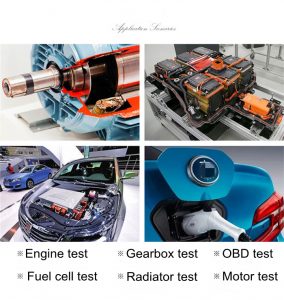Introduction to heating cooling temperature control system of fermentation tank

In the pharmaceutical and biochemical industry, the fermentation tank needs to be equipped with a heating, cooling and temperature control system to control the temperature in the system. The LNEYA refrigeration, heating, cooling and temperature control system realizes the internal temperature control through the external connection of the fermentation tank.
Because the temperature of the fermentation tank has a great impact on the fermentation process, in addition to the direct relationship, humidity also affects the physical and chemical properties of the reaction solution, such as the viscosity of the reaction solution, the solubility and transfer rate of the substrate and oxygen in the reaction solution, the decomposition and absorption rate of some substrates, the kinetic properties of fermentation and the biosynthesis of products.
The fermentation temperature of the fermentation tank is not only applicable to the growth of bacteria, but also to the synthesis of metabolites. It changes with the type of microorganism, composition of culture medium, conditions and growth period. During the whole fermentation process, not only a culture temperature should be selected, but also different culture temperatures should be selected according to different stages of fermentation.
In actual production, because of the large volume of fermentation liquor and the temperature that is difficult to be raised, the more appropriate temperature of culture is often selected during the whole fermentation process to make the yield better, or adjust it appropriately under possible conditions. The growth stage should choose a more suitable growth temperature, and the product secretion stage should choose a more suitable production temperature.
The fermentation temperature needs to be controlled, and then it needs to be measured first. The fermentation temperature can be detected by thermometer or automatic recording equipment, and adjusted by using cold water, hot water or heat transfer oil into the fermentation tank jacket or coil.
In industrial production, generally used large fermentation tanks do not need to be heated during the fermentation process, because the fermentation releases a large amount of fermentation heat. In this case, cooling is usually required. Use automatic control or manual control valve to heat the low-temperature medium of the refrigeration circulator to connect the jacket or coil, and cool and maintain constant temperature fermentation through the heat exchange principle.
Related recommendations
-
After Adding A Backwater to the Heater, Hot Water Will Come Out Anytime and Anywhere in Winter
945The principle is also simple. A water pipe is added at the outlet of the hot water pipe to form a closed circuit. The recirculation pump is connected to the water heater. When the tap is turned on, the circulating pump automatically pumps the col...
View details -
Cooling system of liquid-cooled energy storage cabinet-chiller
1119With the development of new energy technology, the application of containerized energy storage systems in new energy, photovoltaic, and electric energy stations has increased. If the temperature of the energy storage battery pack is not well...
View details -
How to reduce the failure rate of the new energy motor test water cooling system?
977New energy motor test water cooling system needs to pay attention to use during use, no matter how good equipment is used for a long time, some problems will occur more or less. So, how can we minimize the failure rate of the equipment during use?...
View details -
Summary – the cause of the failure of the 85 ° C ultra-low temperature refrigerator
920-85 ° C ultra-low temperature refrigerator in industrial cold treatment, with the development of industry, the scope of use is also wider. However, in the process of use, it will inevitably lead to failure, so how much do you know about common fau...
View details
 LNEYA Industrial Chillers Manufacturer Supplier
LNEYA Industrial Chillers Manufacturer Supplier












